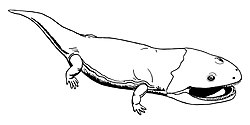| Arcadia myriadens Temporal range: | |
|---|---|
 | |
| Restoration of Arcadia myriadens | |
| Scientific classification | |
| Domain: | Eukaryota |
| Kingdom: | Animalia |
| Phylum: | Chordata |
| Order: | † Temnospondyli |
| Suborder: | † Stereospondyli |
| Family: | † Rhytidosteidae |
| Genus: | † Arcadia Warren & Black, 1985 |
| Species: | †A. myriadens |
| Binomial name | |
| †Arcadia myriadens Warren & Black, 1985 | |
This article needs additional citations for verification .(December 2012) |
Arcadia is an extinct genus of temnospondyl amphibians in the family Rhytidosteidae from the early Triassic. The remains were found in and named after the Arcadia Formation of Australia. [1] [2]

